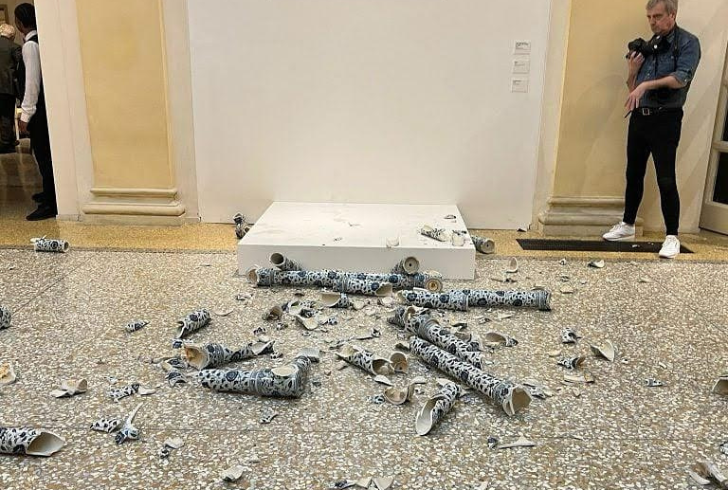An unexpected and shocking incident occurred during the opening of a highly anticipated art exhibition in Bologna, Italy, when a man destroyed a prominent sculpture by renowned Chinese artist and activist Ai Weiwei. The incident took place at the Palazzo Fava, where Ai Weiwei's exhibition "Who am I?" was being unveiled.
The artwork in question was the artist's notable large-scale creation, Porcelain Cube, which stood at the heart of the exhibition. Captured on CCTV and shared by Ai Weiwei on his Instagram account, the footage revealed the man forcefully pushing over the artwork, causing it to break. He then held a piece of the shattered sculpture above his head, a provocative gesture that stunned attendees and museum staff alike.
The Identity of the Perpetrator

Instagram | mimesisgallery | The man who destroyed the Porcelain Cube was a known figure in the art world, with a history of disruptive behavior.
According to a spokesperson for the exhibition, the man responsible for the destruction was already known to the art world. The curator of the show, Arturo Galansino, acknowledged the perpetrator’s long history of controversial actions at various art events. Galansino explained, "This individual has been involved in several disruptive acts in the past, particularly in Florence, where he has caused damage to exhibitions and institutions. This is unfortunately not the first time he's been involved in such incidents."
Local authorities swiftly responded to the incident, with Bologna police arresting a 57-year-old Czech man, who had been stopped by museum security. While the police were not immediately available for comment, the swift action by the museum’s security ensured that the situation did not escalate further.
Ai Weiwei's Response to the Incident
Despite the damage, Ai Weiwei expressed concern for the well-being of those present at the event. In response to the destruction, the artist showed relief that no one had been injured. He also requested that the remains of the sculpture be covered and removed, signifying his respect for the piece, even in its damaged state.
The exhibition continued as planned, with the Porcelain Cube replaced by a life-size print of the original work. The show, which delves into themes of identity and personal reflection, will remain open until May 4. It remains a significant event in the world of contemporary art, despite the disruption caused by this unfortunate incident.
The Cultural and Artistic Impact

Instagram | galleriacontinua | Ai Weiwei's provocative art gains attention after the destruction of his Porcelain Cube, raising concerns about art protection.
Ai Weiwei's art, known for its political and social commentary, gains further traction with the destruction of his Porcelain Cube. This incident highlights the challenges faced by institutions in protecting art, while also sparking discussion about the balance between artistic expression and public safety.
The Cube's visual appeal, blending tradition and modernism, reflects Ai Weiwei's ability to provoke thought. Its destruction raises questions about the role of art, the artist's responsibility, and the audience's engagement. Museum officials will undoubtedly discuss improved security measures to prevent vandalism and ensure art fosters meaningful dialogue.
A Shocking Turn of Events
Though this episode was certainly an unexpected turn of events at the art show, it brings to light an important aspect of the interaction between art and public perception. The Porcelain Cube may have been damaged, but the exhibition's message and impact remain intact. Ai Weiwei's works are not only admired for their aesthetic value but also for their ability to challenge and provoke audiences in ways that sometimes, even unintentionally, create dramatic situations.
As the art world continues to grapple with the implications of this incident, one thing is clear - the provocative and boundary-pushing nature of Ai Weiwei’s work will continue to stir up conversations, challenging audiences to think critically about art, society, and freedom of expression.




